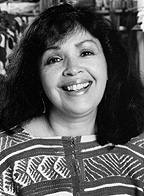LITR 4332: American Minority
Literature

Student Poetry Presentation 2004

“La
Migra” by Pat Mora
UA 367-368
Biographical
Information:
Pat Mora, a leading figure in contemporary Hispanic
poetry, was born on January 19, 1942 in El Paso, Texas.
As a child growing up in El Paso, Texas, Mora struggled with her Mexican
heritage, often shunning it to fit in with regular “Americans.”
While starting a family, earning college degrees, and teaching, Mora
began to appreciate the richness and influence of her native culture in El Paso.
This strong personal awakening also compelled her to write.
The mother of three grown children, she now lives in Santa Fe, New
Mexico.
Literary Terms:
Tone: The attitude of the author toward the subject
matter of a literary work. The author’s tone may be serious, playful, mocking, angry,
and so forth. Pg 482 Bedford Glossary
Symbolism: The
use of symbols to represent or suggest other things or ideas.
It also refers to the presence, in a work or body of works, of suggestive
associations giving rise to implied meaning.
Pg 472 Bedford Glossary
Objectives:
2c "Quick
check" on minority status: What is the individual’s or
group’s relation to the law or other dominant institutions? Does "the
law" make things better or worse?
3c.
Mexican American narrative: “The Ambivalent Minority”:
("Ambivalent" means having "mixed feelings" or
contradictory attitudes. Mexican Americans as a group may feel or exemplify
mixed feelings about whether they are a distinct, aggrieved minority group or
another immigrant culture that will assimilate culture as individuals or
families who come to America for economic gain but suffer social dislocation. On
the other hand, much of Mexico's historic experience with the USA resembles the
experience of the Native Americans: much of the United States, including Texas,
was once Mexico. Does a Mexican who moves from Juarez to El Paso truly
immigrate?)
5a.
To discover the power of poetry and fiction to help "others" hear the
minority voice and vicariously share
the minority experience
5c.
To regard literacy as the primary
code of modern existence and a key or path to empowerment.
5f. To generalize the "Dominant-Minority" relation to philosophical or syntactic categories of "Subject & Object," in which the "subject" is self-determining and active in terms of "voice and choice," while the "object" is acted upon, passive, or spoken for rather than acting and speaking.
Interpretation
of Poem:
The
poem almost sounds like children role-playing.
This is shown when the author says “I’ll be the Border Patrol, You be
the Mexican Maid.” The symbols used in the poem are symbols of authority.
Symbols – badge, handcuffs, boots, and a gun.
This is clearly a poem about dominance and control.
In the first part of the poem, the border patrol has authority.
However, the control is flipped in the second part.
The Mexican maid takes control in the second part of the poem, and she is
no longer a maid. The author
writes, “You be the Border Patrol, I’ll be the Mexican woman.”
Mora also shows us control and disadvantages through language barriers.
This is illustrated in the first part when the author writes, “don’t
ask questions because I don’t speak Spanish.”
We see it illustrated in the second part when the author writes, “Agua
dulce brota aqui aqui aqui, but since
you can’t speak Spanish, you do not understand.” The poem does not say much, but as Jennifer Carnes from
the 2001 class states, “Sometimes the less you say and are given, the more
powerful it is.”
Questions:
Why
do you think Mora referred to the woman as a maid in the first part of the poem?
Why
do you think Mora shows us the power shifting in the second part of the poem?
Why
do you think she refers to the border patrol’s objects as heavy in the second
part of the poem?